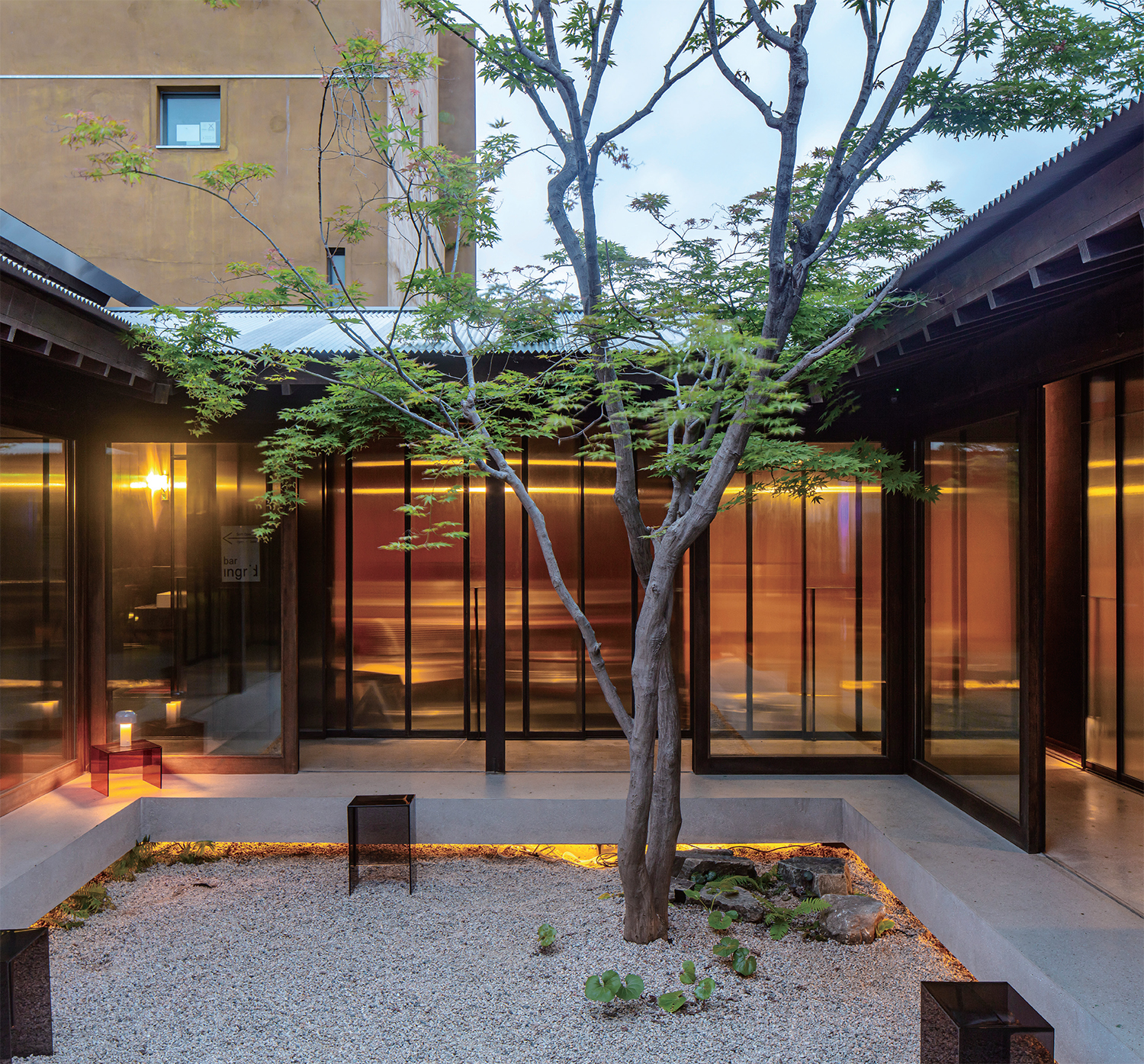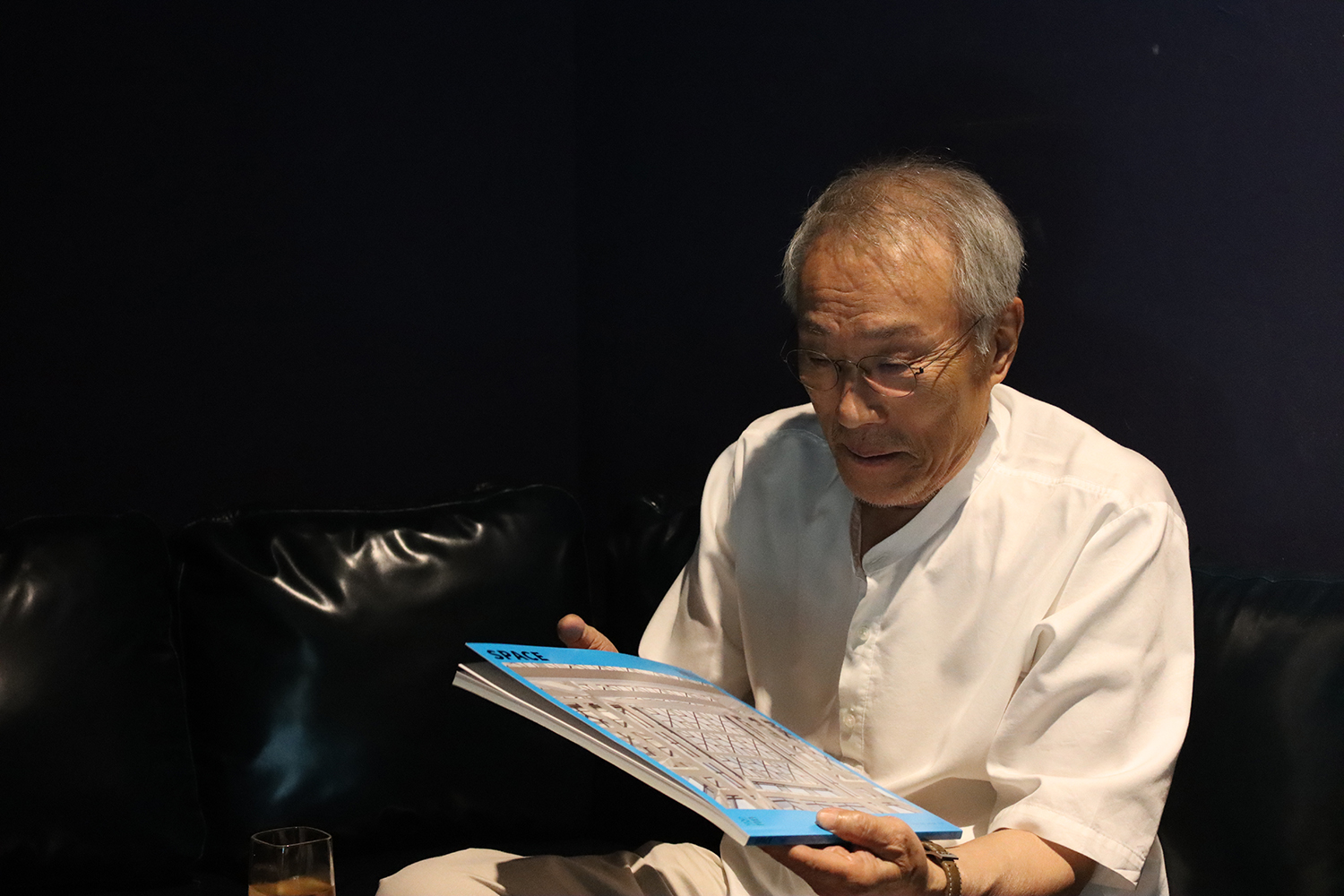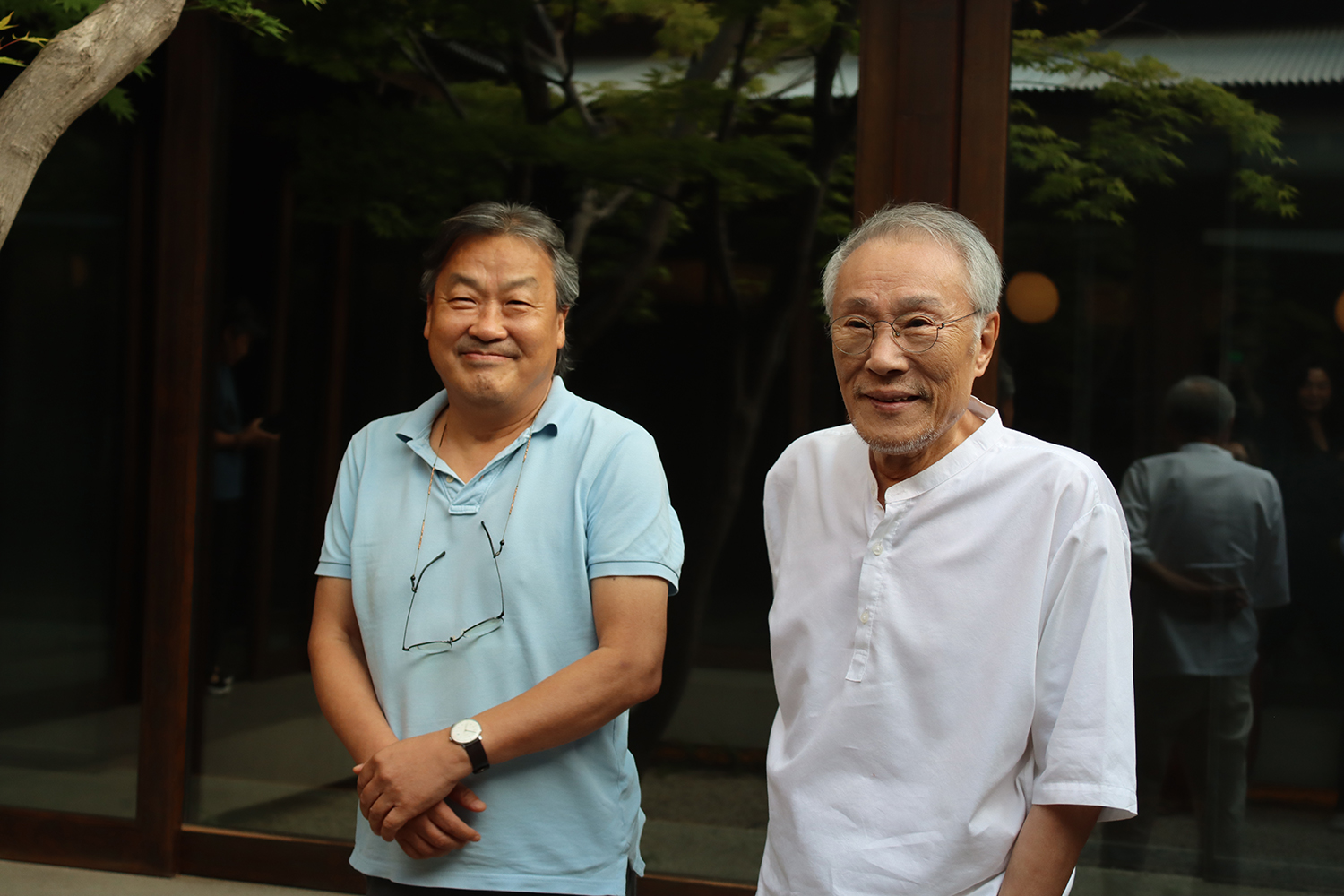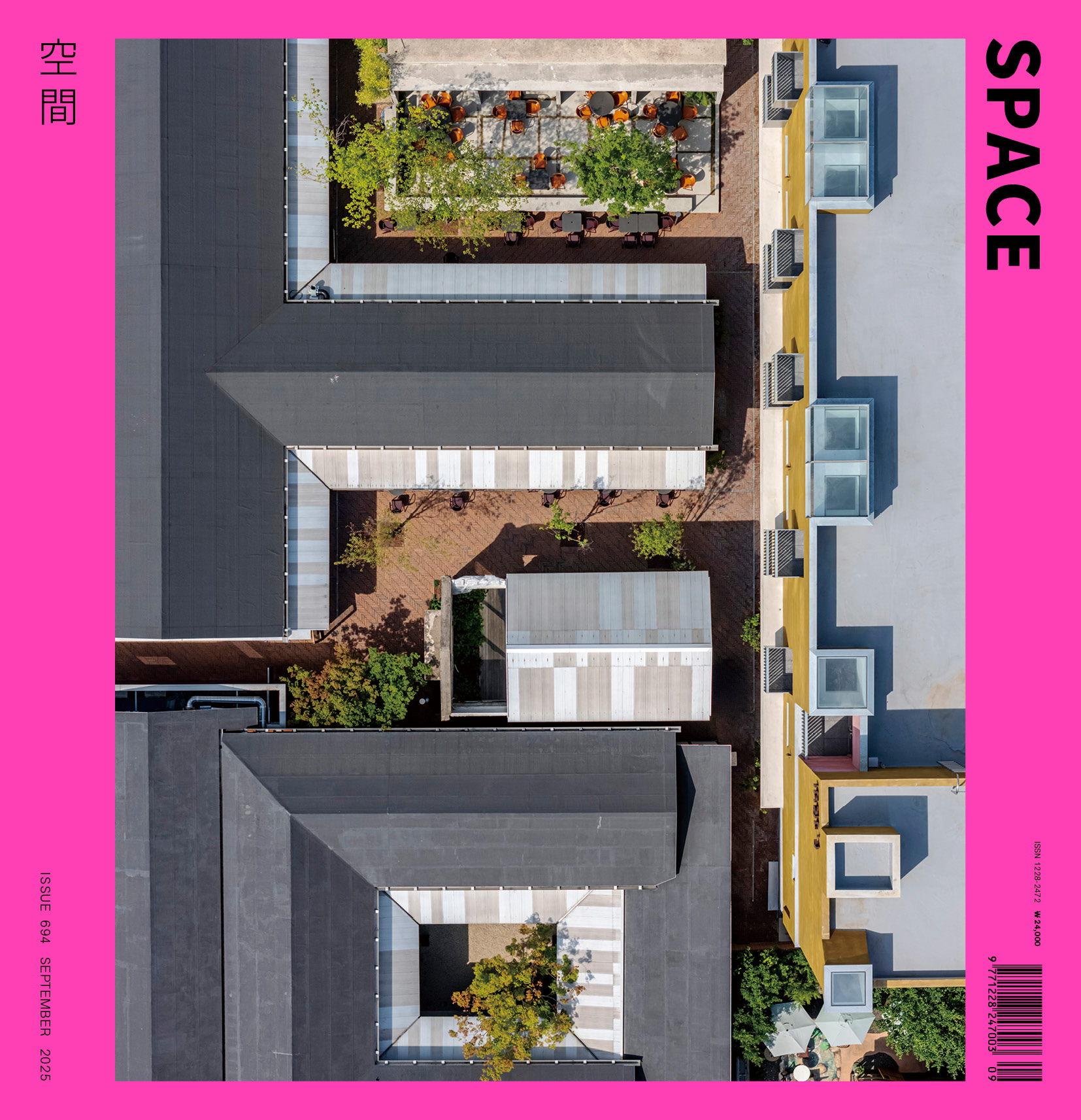SPACE September 2025 (No. 694)

Interview Hwang Sok-yong novelist × Kim Jeoungeun editor-in-chief
The City of the Other
Kim Jeoungeun (Kim): It is well known that you have traveled to many cities and across many countries. You were born in Manchuria in 1943, spent time in Pyongyang, then moved south and spent most of your youth in Yeongdeungpo, Seoul. In the 1970s, while writing Chang Kil-san, you moved to Haenam, and later witnessed the rise of the Gwangju Democratization Movement. You also served in the Vietnam War. After visiting North Korea, you were unable to return to South Korea, and spent periods in the New York and Berlin. You were later imprisoned in connection with these experiences. More recently, you were living in Iksan, and a few years ago, I understand you relocated to Gunsan. What brought you to Gunsan?
Hwang Sok-yong (Hwang): I had been living in Iksan since 2018, until in 2021 a cultural foundation in Gwangju, Gyeonggi Province, offered me a private writing studio. They even remodeled it for me. The place was surrounded by mountains, with a river in view, and the scenery was truly splendid. I suppose they thought a writer would produce better work in such surroundings, but it turned out I was completely alone in the middle of a forest. Living high up in the mountains came with its inconveniences. After spending two winters there, I began to think it might be time to move on. In the end, some younger colleagues said, ‘How about coming over here to be with us?’and that’s how I ended up in Gunsan.
Kim: What was it about Gunsan’s history, architecture, or nature that led you here?
Hwang: The only time I’d been to Gunsan before was when I was young. Iksan is convenient enough for getting around, but Gunsan isn’t a place you just pass through on your way somewhere else. Back then, it had the atmosphere of a small Japanese provincial port town—rows of elegant Japanese-style houses lined up neatly. Now it feels more like being back in the 1970s and 1980s, which I also like. When you’ve lived as long as we have, you can see how buildings and cities change.
In many ways, it reminds me of Yeongdeungpo. I came down from the North when I was four and lived in Yeongdeungpo, Daebang-dong, and Yeouido until I was thirty. Both Yeongdeungpo and Gunsan were industrial cities built by the Japanese, and the way layers have been added over time – the process, the scenery – feels very similar. Cities that went through the colonial period often have certain things in common, like the old honmachi street in front of the station. That’s why it all feels so familiar.
Kim: One literary critic once said you live out a kind of voluntary diaspora.
Hwang: The word diaspora is kind of a cliché. To put it in more academic terms, Heidegger said that modernity is an age in which all sense of ‘home’ has disappeared. That is why modern man must return to his home. But by ‘home’ he means one’s authentic existence, a place closer to the origin. But even without that heavy meaning, I always feel like someone who doesn’t really ‘dwell’ anywhere. Wherever I go, I’m just passing through. After two or three years in one place, I start to feel restless—‘I’m getting bored,’ I tell myself. Whether in Gunsan, Iksan, or some unfamiliar city, I still carry the same feeling I had when I was in exile. After visiting North Korea, I spent two and a half years in Berlin, then another two and a half in New York. After the Cold War ended, I spent two and a half years in London in the 2000s, then the same in Paris. In total, about a decade between Europe and the United States. After experiences like that, the actual location stops mattering so much. I think the word glocal – holding both the global and the local – suits me. Whether it’s a small, underdeveloped Korean town, Dubrovnik in Croatia, or Dublin, they’re all the same: just places. The memories, I have to create myself. I’ve always had that mindset. Now that I’m in my eighties, I feel my energy isn’t what it used to be. I find myself thinking, ‘The end is near. I should prepare the place where I’ll die.’ In the old days, when people moved, they used the Japanese word nizukuri (にづくり) for ‘packing up’. Preparing for death is a kind of nizukuri too. For a writer, death is both a rite of passage and the final act of shaping oneself. So yes, I believe even death, and the place where it happens, should be carefully made.
Kim: So, Gunsan wasn’t just a place you happened to pass through—it was a destination you chose with a purpose in mind.
Hwang: Exactly. I had to decide: would I die in some pastoral place with a waterwheel turning, or in a foreign land as a stranger? Either way, it’s dying away from home. But, I thought, at least let it be somewhere that fits. If I were to define my literature, I’d say I’m a writer of a divided era. For the past seventy or eighty years, everyone in my generation has lived under those same circumstances. But that’s too blunt. If you look one step deeper, I see the last hundred years, including the division, as the modern era, and I believe East Asia has yet to overcome it. Outwardly, in trends and habits, we seem postmodern, but when you peel back the layers, we’ve never truly moved past modernity. And it’s not just us—China and Japan, too. Japan still has the Emperor – he’s not an individual, he’s a system – so the leadership retains that old militarist inertia. We, meanwhile, have yet to achieve a unified modern nation-state, still wrestling with modernity. China, as you know, went through a socialist revolution, but outwardly it’s a deeply corrupt high-tech capitalism, while inside it’s still socialist. None of us have overcome modernity. So where does that leave me? I’ve been writing novels around the theme of both overcoming and embracing modernity, and Gunsan happens to hold elements that fit that theme. Gunsan is not a city of natives—it’s a city of others. That makes it less hostile to newcomers. For someone just passing through, it’s an easy place to settle for a while.
Kim: So you’re saying Gunsan’s history – first shaped by the Japanese, and later by the U.S. military after liberation – lent the city its openness towards outsiders. And that openness resonated with your own tendency to never stay in one place for long, as well as with the central themes in your fiction.
Hwang: My recurring theme, overcoming and embracing modernity, might not be so different from the way an architect thinks. After all, one seeks memory and identity through space, and the other builds these things through stories. Architecture that carries a sense of narrative, and novels that possess a sense of space—those values can cross over and speak to each other.

Hwang Sok-yong. ©Bang Yukyung
How Do the Past and Present Meet?
Kim: You’ve often said, ‘Writing is labour.’ I sense the truth of this statement in the sheer scale of your research. For example, in Mater 2-10 (2020), which spans over a century, the geographical and urban details of places like Yeongdeungpo, Yeouido, and Incheon are painted with almost visual clarity. The sections on railroads – modernity’s emblem – carry both concrete detail and sweeping insights. You seem to conduct research that’s broader and more specific than most modern history scholars. That makes me wonder: for a novelist working with the long sweep of history, what does the process of turning that into a story actually look like?
Hwang: You can’t just transplant historical facts directly onto the page. You have to transform them into lived experience, into the everyday. Old books like the Dongguk Yeoji Seungnam or local gazetteers already have the descriptions. So I take a sheet of A4 paper and start drawing. Say I’m writing a scene set in a market, then I’ll map it out: where the fabric shop sits just past the medicine stalls, where the pottery stand is, and so on. Once that’s laid out, the picture is in my head, and I can write from there. With Mater 2-10, it was easier because it’s set in Yeongdeungpo, a place that holds my own memories. The characters are drawn from real people—like the sweet potato vendor I saw in the market back then, or a woman I met after running away from home in elementary school. Those recollections seep into the fiction.
Kim: In 2021, at an invited lecture for writers, you said you wanted to ‘merge traditional Korean narratives with the realities of contemporary life’ in your work.
Hwang: I once met the British novelist Margaret Drabble, and after reading The Guest (2001) she told me it felt like the Korean version of the magical realism of Latin American writers like Gabriel García Márquez. I told her no—it’s what I call mindam (folk-tale) realism. I coined the term myself. What’s a mindam, and what’s history? History is about taking the everyday lives of ordinary people, finding what’s essential in them, and giving them value—deciding what’s right and wrong so they can be remembered. A mindam is the stage before history: when daily life is embellished or mingles with imagination. For example, someone who’s been to Namdaemun Gate might say, ‘You know, Namdaemun Gate is so tall it’s almost as high as Namsan Mountain. People passing underneath look like ants’. But someone who’s never been to Seoul wouldn’t know that. Mindam works like that—it satisfies a longing. And literature begins in that world. Which is why, in the end, you can’t deny that literature is, at its core, a kind of tall tale.
Kim: You’ve even been nicknamed one of the ‘Three Great Tall-Tale Tellers of Joseon’—a master storyteller, as they say. (laugh)
Hwang: That’s exactly why literature exists—for the warmth, the humanity, the sense of life you find in those in-between spaces. Otherwise, why would you read novels instead of history books?
Kim: In the case of Project Re\Turning Gunsan (hereinafter Re\Turning Gunsan), the aim goes beyond simply preserving or restoring existing houses. It’s about carrying forward the accumulation of lives within them. Fusing and sustaining the past and present is, I think, a shared task for any creative work seeking identity, regardless of genre. From that perspective, what are your thoughts on Re\Turning Gunsan or similar projects to regenerate historic buildings?
Hwang: Re\Turning Gunsan is born of good will and has been relatively successful compared to other cities. In Iksan, for instance, most old buildings have become near-ruins. Real estate prices are so high that the authorities can hardly intervene. And when partial vacancies appear, people prefer to demolish and put up apartment blocks. But memory is vital—it shapes our lives and allows the past and present to meet. Architecture, especially, differs from era to era because ways of living differ. Buildings are places where memories are stored. Gunsan was turned into a colonial city under Japanese occupation, then later became an entertainment district under the U.S. military. These layers of history hold the life stories of different generations. If we could turn that texture of life into a strength – weaving stories from it and interpreting alleys and streets architecturally – that would be ideal.

Son Jean (left) and Hwang Sok-yong (right). ©Bang Yukyung
A Cultural Companion to Overcoming and Embracing Modernity
Kim: You’ve also been called the ‘Hwang Forrest Gump’ of modern Korean history, for being present at so many key moments. I hear that you’re now planning a festival – tentatively titled ‘KAALA’ (Korea with Asia, Africa, Latin America) – with the subtitle ‘Re-constructing Cultural Solidarity of the Global South and Re-storying the Post-Colonial City of Gunsan’, aiming to launch in the second half of next year. It feels like you’re moving from filling historical gaps through novels to fostering a larger sense of solidarity in Gunsan.
Hwang: KAALA is, in a sense, a form of closure. In Korea, it’s common to name a literature museum or an award after a writer. But my view is different. There are already 148 literature museums here, many of them grand buildings funded by the state. In Europe, you remember artists with something as modest as a small plaque—think of Hemingway, Beethoven. Even after I’m gone, KAALA will remain in this city. KAALA also fits the identity of Gunsan and of our nation. There are three kinds of countries in this world: those that practiced imperialism, those that never had the chance, and those that were colonies. The truth is, the modernity of every country is distorted. Imperial powers built their modernity by taking from others and enriching their own. We, on the other hand, were colonised, yet within a single generation achieved both industrialisation and democratisation— though at the cost of internal sacrifice. That’s remarkable. Now people call us a developed nation. We’ve come this far, yet many of our friends are still struggling. So shouldn’t we play the role of the elder brother? The idea is to build a civilisation distinct from imperialism together with them. It’s a matter of shared humanity, but also of planning for the future of the global community. Culturally, this is the ‘Third World’; economically, ‘developing countries’; in diplomacy, ‘the Non-Aligned Movement’. The conditions haven’t changed much over time. Today, with the U.S. and China still locked in conflict, we need to find our own way. The term ‘Third World’ isn’t much used anymore— even the ‘Middle East’ is a Eurocentric term. We have to ask ourselves: what stance should we take? ‘Global South’ is not a perfect expression either, but I see Gunsan as holding the right narrative for postcolonial countries to gather and talk about decolonisation. Overcoming modernity and deciding what to embrace—that’s not only my theme, but also Gunsan’s, and part of its identity.
Kim: What kinds of activities will KAALA involve in practice?
Hwang: In the mid to late twentieth century, the Writers’ Union of Asian-African-Latin American (AALA) sought a shared postcolonial identity through cultural solidarity. They founded the Lotus Literary Prize and worked to bring the unique imagination and lived realities of ‘Third World’ literature to global attention. Recently, the Writers’ Union of AALA in Egypt has been reviving this movement. While KAALA is a separate initiative, it will work in solidarity with that spirit—hosting a KAALA Festival in Gunsan, biennially. We’ll hold our inaugural meeting on the 4th of August. Under the name of Korea with AALA, we’ll use literature, art, and documentary film to propose a new kind of South- South cultural cooperation. We’re creating the Guardian Tree Prize to honour achievements in literature, visual art, film, and also environmental peace. Artists from across the Global South will be invited, with events held throughout Gunsan. I’m the chairperson, and our board members, myself included, will contribute our own funds as well as seek donations. That way, we have substance and can attract support from government or business. If you start something like this under government leadership from the outset, it’s hard to succeed. The Busan International Film Festival thrived because it began as a civic initiative. In the end, it’s the citizens who must awaken. The same goes for architecture and small-city issues—it has to come from the locals, not outsiders. Re\Turning Gunsan began when citizens stepped in, just before the area became a ruin.
Kim: What about small cities that don’t have special cultural or historical assets? Or is that question itself based on a wrong assumption?
Hwang: It’s a wrong assumption. Judging a city’s value based on cultural heritage or industry comes from a central or Seoul-centric, hierarchical view. Lives are all different, and so are cities. You need to be on the ground, talking to people, drawing out their ideas for urban regeneration, so the texture of local life reveals itself. Architecture isn’t an ‘event’—it’s everyday life. And small cities should be reshaped by the bustling everyday lives of their residents. I love what architect Chung Guyon once said: ‘I’ve never created anything; I’ve only reproduced the imagination of the people who live there.’ That’s where the answer lies for both regional extinction and regeneration. In Muju, he was asked to design a township office, but when local elders asked for a bathhouse, he made one – attached to the office – something unheard of in Korea.
Kim: Finally, can we expect a new novel set in Gunsan from you?
Hwang: I’m writing a story called ‘Halmae’ (Granny) about a hackberry tree over 600 years old inside the U.S. military base in Gunsan. After years of protest, citizens succeeded in moving the barbed-wire fence inward, putting the tree outside the base. It used to be a ‘California tree’, but now it’s a Joseon tree. (laugh) We’ve named our new KAALA award – the Guardian Tree Prize – after it.
You can see more information on the SPACE No. September (2025).

Hwang Sok-yong
Hwang Sok-yong was born in 1943 in Changchun, Manchuria, and graduated from the department of philosophy at Dongguk University. While still in high school, he won the Sasanggye New Writer’s Award for his short story Near Ipseok (Near the Marking Stone). In 1964, he was arrested during protests against the Korea- Japan Treaty and spent time in a police holding cell, after which he traveled around construction sites across the country, following a day labourer he had met there. He later enlisted in the Marine Corps, served in the Vietnam War, and drew on that experience to write the short story The Pagoda, which won the Chosun Ilbo New Writer’s Literary Contest in 1970, marking the start of his full-fledged literary career. In 1989, he traveled to North Korea and was unable to return to South Korea, remaining in Germany as a guest writer at the Akademie der Künste (Berlin). Upon returning to South Korea in 1993, he was sentenced to seven years in prison for the unauthorized visit to the North, and was released in 1998 through a presidential pardon. His major works include the epic novel The Shadow of Arms (1989), which offers a sweeping portrayal of the Vietnam War and earned him the Manhae Prize for Literature, and The Old Garden (2000), which depicts the lives of those who fought for social transformation after the collapse of socialism and won both the Danjae Literary Prize and Isan Literary Award. In 2001, he received the Daesan Literary Awards for The Guest, a novel inspired by the Sinchon Massacre in Hwanghae Province. The Guest, Shim Cheong, Lotus Path, and The Old Garden were finalists for France’s Prix Femina, with The Old Garden also named ‘Book of the Year’ in France and Sweden. His novel At Dusk won the Émile Guimet Prize for Asian Literature in France, and Mater 2-10 was shortlisted for the International Booker Prize.
1




